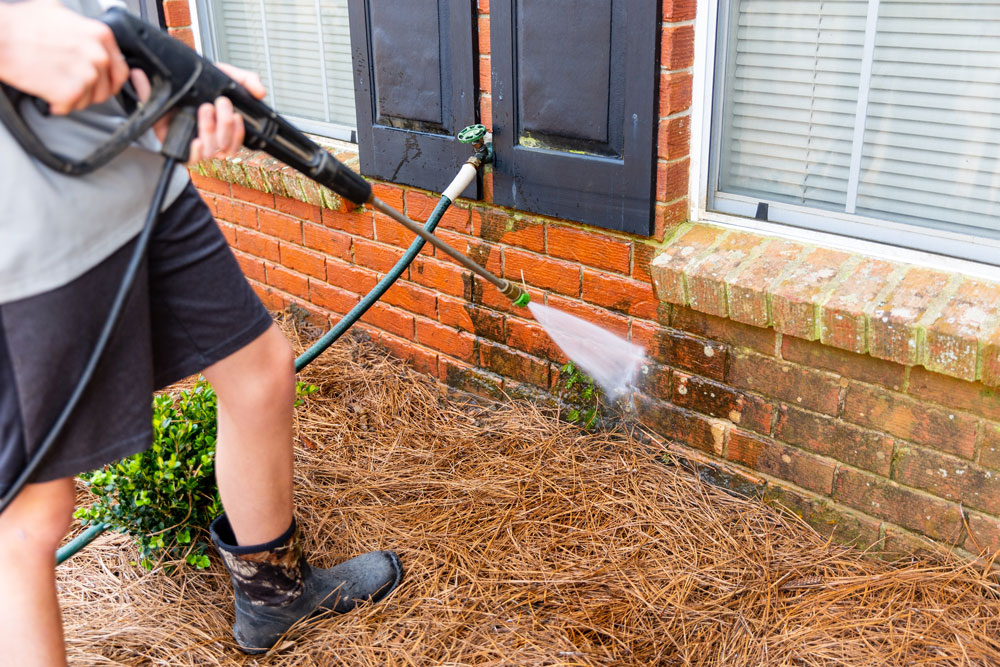What Is Brick Cleaning Acid?
 CONTENTS
CONTENTS
- What is brick acid?
- What is it used for?
- Is brick acid dangerous?
- Can brick acid damage bricks?
- How to clean bricks with brick cleaning acid
- Contact us today
Brick cleaning is a popular solution for getting rid of built up stains and grime, and even mortar smears on brickwork. But cleaning with brick acid can be dangerous and difficult, and should always left to professionals.
Our brick cleaning specialists are available nationwide, 365 days a year. They have access to industry-leading solutions so they can remove a range of stubborn substances from any surface including dirt, moss, and paint.
Keep reading to learn more about brick cleaning acid and how it's used to clean bricks.
What is brick acid?
Brick acid, commonly known as hydrochloric or muriatic acid, is a potent solution used in the construction industry. It's highly effective at removing stubborn stains and excess mortar from bricks. You can find out more about brick acid here.
This powerful cleaner should be handled with care due to its corrosive nature. Brick acid works by reacting with the alkaline substances on brick surfaces to break them down, making it easier to wash away unwanted residues.
If you are considering using this substance for cleaning projects, it's crucial to understand both its potential and risks. That is why many turn to professionals for safe application.
What is it used for?
The primary use of brick cleaning acid lies in refurbishing exterior walls and structures where dirt build-up or residual mortar has occurred post-construction. Its high efficacy makes it a go-to choice for builders looking to clean up new builds.
Moreover, when older buildings undergo restoration works, this powerful cleaner helps restore their original look by eliminating layers of dirt that have accumulated over several years without causing harm to the integrity of the bricks.
Brick acid is also used on concrete and paving slabs where similar unsightly marks appear over time, but it can cause damage to these surfaces. Certain surfaces should not be cleaned with brick cleaning acid including sandstone, limestone, and granite as it will damage the stone and draw out iron deposits.
Is brick acid dangerous?
The corrosive nature of brick cleaning acid poses serious health hazards. Direct contact can cause severe burns on the skin and eyes. Inhalation of fumes may lead to respiratory problems such as bronchitis or pneumonia, as well.
Beyond personal safety concerns, brick cleaning acid can also damage property if not used carefully. It's capable of discolouring bricks and corroding metal surfaces like door handles or window frames.
The harmful effects it can have on the environment is another critical consideration in using this type of product. Improper disposal could contaminate water sources causing harm to aquatic life forms.
Given these dangers, it's always advisable to seek professional help when dealing with heavy-duty cleaners like brick cleaning acid.
Can brick acid damage bricks?
If misused or overapplied, brick acid can damage brickwork. But when correctly diluted and applied by specialists, these risks are minimised significantly.
The primary risk lies in the concentration of the acid. High concentrations can erode mortar joints and even etch into the surface of the bricks themselves, leading to structural problems over time. To avoid these issues, bring in skilled technicians who know exactly how much product needs applying and how best to apply it.
How to clean bricks with brick cleaning acid
Brick and stone cleaning should always be left to professionals, particularly if brick cleaning acid is required. They will start by putting on protective gear like gloves and goggles to protect their skin and eyes.
Then, they will mix the solution and dilute the acid to the optimal amount. Too strong and you could end up damaging your lovely bricks; too weak and it will not do its job.
Next, they will apply it with specialist equipment, ensuring they reach all the bricks, and apply the solution thoroughly. Finally, they will leave it on for just the right amount of time before rinsing thoroughly with water.
Professional cleaners will have high-pressure washers that make sure every nook and cranny gets attention without harming mortar joints or surrounding areas. They will also be qualified to work at height safely and can ensure a thorough clean without risking injury.
Brick cleaning specialists can even identify the optimal cleaning method for your brickwork and will able to determine if brick cleaning acid is required, or if there is a better, more gentle option to minimise the chances of damage. You can find out more about how to clean brickwork without brick acid in this blog.
Contact us today
Our brick cleaning experts will only use eco-friendly solutions to ensure a thorough, safe clean. During your service, they will most likely use the TORIK Brick Cleaning System which releases a controllable jet of superheated water to blast off even the most stubborn grime and stains.
To book your brick clean, get in touch with our team on 0208 066 0360 or enquiries@icecleaning.co.uk. They will be happy to book your free site survey and give you a no-obligation quote for our brick cleaning services.

Speak with me today,
I’m here to help
By asking you a few questions either via phone or email I can immediately provide a realistic estimation of the cost.
You’re in good company. We’ve cleaned for the following commercial clients… View all

Why choose us?
- Cater to a wide variety of cleaning situations
- Nationwide coverage, available 24/7
- Cater to commercial and domestic clients
- Free survey provided prior to quotation
- Emergency response team
- Offer a bespoke service designed to suit all your needs
- All technicians hold professional health and safety qualifications, including BICSc, IOSH, Dewpoint Professional & Safe Contractor
We’re fully accredited
We place best practise, professional expertise and health and safety at the core of our business. We’re fully compliant with all legal obligations. You can view a list of our accreditations below, or visit our Health & Safety page for more information.











-RGB-small.1707319151.jpg)




















